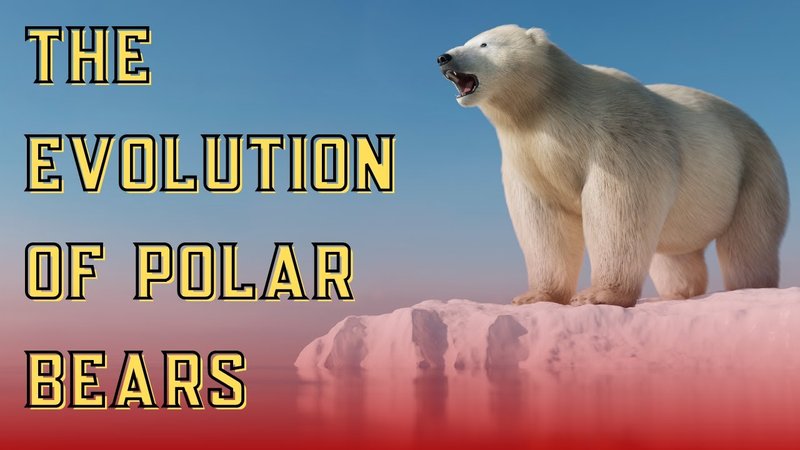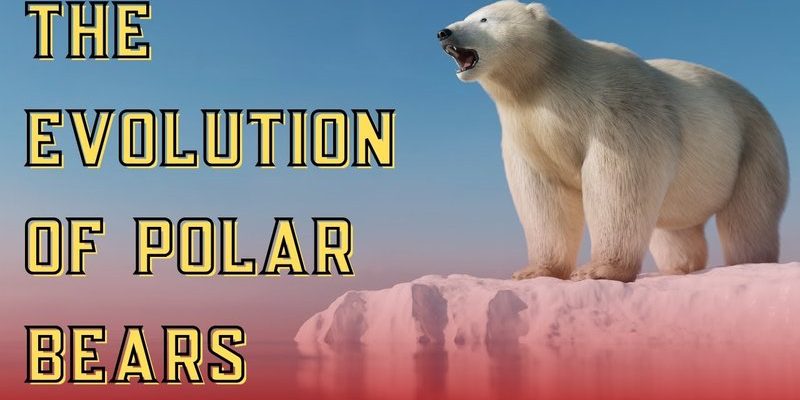
Let’s treat this like a cozy chat over coffee where we’re unpacking the polar bear’s family tree, diving into its ancestors, and discovering how climate and environment shaped this incredible animal. From its origins to its present-day struggles, the evolution of the polar bear is a tale of survival, adaptation, and resilience.
Origins of the Polar Bear: Where It All Began
The story of the polar bear starts millions of years ago, long before they roamed the icy Arctic. Polar bears belong to the family *Ursidae*, which includes all bears, and their direct ancestors can be traced back to the brown bear. Around 600,000 years ago, a population of brown bears began to adapt to life in the cold, icy climates of the Arctic regions. This was no small feat; these bears had to evolve physically and behaviorally to survive.
You might be wondering what changes occurred during this transformation. Well, as the climate cooled and glaciation spread, those bears developed thicker fur, a layer of blubber for insulation, and their diet shifted to include more seals and marine life. This shift in diet has a huge impact; it not only influenced their hunting tactics but also contributed to their unique adaptations like their incredible swimming abilities.
Here’s the thing: these early polar bears were not the all-white giants we know today. They had a darker coat that served them well in their brown bear homeland. Over time, as they adapted to the icy environment, their fur lightened to blend in with the snowy landscape. This change was crucial for hunting, allowing them to sneak up on their prey without being easily spotted.
The Physical Transformation: Adapting to Ice
As polar bears continued to evolve, they underwent significant physical changes to become the icons of the Arctic we see today. One of the most remarkable adaptations is their body shape. Polar bears developed longer bodies and larger skulls, which help them cover greater distances while hunting seals. They’re built for endurance, capable of swimming for days at a time.
Their paws are another fascinating feature. Polar bears have large, furry feet that act like snowshoes, distributing their weight over a larger area. Not only does this help them walk on thin ice, but it also aids in swimming. Their webbed toes assist with propulsion in the water, making them excellent swimmers—a handy trait when pursuing seals under the ice.
Let me explain something important: these adaptations aren’t just interesting; they’re vital for survival. The Arctic is a challenging environment with extreme cold and limited food sources. The evolution of the polar bear showcases nature’s ability to fine-tune a species to fit its surroundings perfectly.
Genetic Variations: Polar Bears vs. Brown Bears
Interestingly, polar bears maintain a genetic link to their brown bear relatives, which highlights their shared ancestry. Studies of their DNA reveal that polar bears are more closely related to brown bears than to any other bear species. This connection is crucial for understanding how different environments can shape similar species in distinct ways.
One fascinating aspect of their genetics is the adaptative traits they share with brown bears. These traits are not just limited to physical characteristics but also include behaviors. For instance, polar bears have been observed displaying similar hunting techniques to brown bears, like using stealth to catch prey. However, through evolution, polar bears have adapted these techniques to suit their icy habitat and blubbery diet.
In recent years, hybridization between polar bears and brown bears has become more common as climate change pushes polar bears to venture further south in search of food. These hybrids, often called “pizzly bears,” show how flexible and resilient bear species can be, adapting to the changing landscape brought on by warming temperatures.
Impact of Climate Change: The Current Struggle
Climate change is a significant threat to polar bears today. As the Arctic warms and sea ice melts at alarming rates, polar bears face challenges in hunting and finding food. With less ice to support their hunting, many bears struggle to catch enough seals, their primary food source. It’s heartbreaking to think about how these majestic animals are fighting for survival due to environmental changes caused by human activity.
Here’s the thing: the melting ice isn’t just a problem for polar bears but also an indicator of the broader health of our planet. The decline of polar bears serves as a wake-up call about the urgent need to address climate change. As these bears struggle to adapt, they remind us of the interconnectedness of ecosystems and the effects of our actions on wildlife.
You might be wondering if there’s hope for the polar bear. Organizations and researchers are working tirelessly to protect these animals by creating conservation programs aimed at preserving their habitats. It’s a reminder that while evolution has equipped polar bears to adapt, human efforts can also pave the way for their survival in the face of unprecedented challenges.
Conservation Efforts: A Light in the Darkness
Despite the dire prospects, there’s still a glimmer of hope for polar bears. Conservation efforts aim to protect their habitats and mitigate the effects of climate change. These programs focus on reducing greenhouse gas emissions, preserving sea ice, and ensuring sustainable practices in the Arctic region.
One successful initiative is the establishment of protected areas that safeguard key habitats for polar bears. These areas serve as crucial breeding and feeding grounds, allowing bears to thrive and maintain their populations. Additionally, organizations collaborate with local communities to promote coexistence, ensuring that both humans and polar bears can share the Arctic landscape.
Honestly, awareness is key. Educating the public about the plight of polar bears is essential for driving change. By fostering a deeper understanding of their evolutionary history and the challenges they face today, we can inspire action and support initiatives that prioritize their survival.
The evolutionary history of the polar bear is incredible, filled with adaptations that showcase nature’s resilience. From their origins as brown bear ancestors to their current struggles in a changing world, polar bears embody the delicate balance between evolution and survival. As we reflect on their journey, it’s essential to acknowledge the role we play in their future.
Our actions today can shape the destiny of these magnificent creatures. By supporting conservation efforts, reducing our carbon footprint, and raising awareness, we can help ensure that polar bears continue to roam the Arctic ice for generations to come. After all, their survival is not just about them; it’s about protecting our planet and its diverse ecosystems. Let’s work together to keep the spirit of the polar bear alive.

